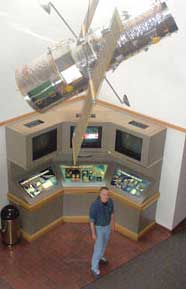The Model Is Not The Reality. It Is Just A Model.
So…in case you’re wondering why your 401k is in the gutter…here’s part of the problem.
This article in Wired explains it in more detail. The above is a formula the gods of Wall Street were using to assess risk. Investors like risk. What they don’t like is uncertainty. If they know how to price risk, then they’ll lend. The greater the risk, the higher the interest rate. If they loose the bet every now and then that’s okay, as long as the rest of the bets pay off and they make money. But when they don’t know how to price risk, they won’t lend.
What makes the current financial mess look disturbingly like the Great Depression is that there is actually a lot of money available to lend, but nobody is lending any. Because nobody feels confidant enough that they understand the risks anymore. They don’t want to loose any more money then they already have. So they’re sitting on what they’ve got. This is why the Federal Government has to step in and inject money into the economy to keep it going. The banks and investors who usually do that…aren’t.
The biggest problem for investors is assessing risk in complex systems, such as the mortgage markets…
What is the chance that any given home will decline in value? You can look at the past history of housing prices to give you an idea, but surely the nation’s macroeconomic situation also plays an important role. And what is the chance that if a home in one state falls in value, a similar home in another state will fall in value as well?
H.L. Mencken once said, "For every problem there is a solution that is simple, elegant, and wrong." Consider the Wired article on the Wall Street collapse an example. The above formula, crafted by mathematician David X. Li, seemed to simply and elegantly solve the problem of assessing risk. But it didn’t. It solved correlation. The best quote in the Wired article I’ve linked to this one, from Nassim Nicholas Taleb, a hedge fund manager and the author of The Black Swan…
"Anything that relies on correlation is charlatanism."
Beware your assumptions. Solving for correlation did not solve for risk. Correlation is pretty poor at solving for anything actually, not just in finances. We know poor people are thieves because we have seen many thieves who are poor. We know Jews are greedy because we have seen many greedy Jews. We know single parent families produce problem children because we have seen so many problem children who come from single parent families. We know homosexuality is caused by being molested as a child, because we have seen so many homosexuals who were molested as children…
You have to be careful where you draw conclusions from. Correlation is not evidence. It is only suggestive. And especially beware of the conclusions you expected. David X. Li’s formula didn’t cause the crash. This did:
The damage was foreseeable and, in fact, foreseen. In 1998, before Li had even invented his copula function, Paul Wilmott wrote that "the correlations between financial quantities are notoriously unstable." Wilmott, a quantitative-finance consultant and lecturer, argued that no theory should be built on such unpredictable parameters. And he wasn’t alone. During the boom years, everybody could reel off reasons why the Gaussian copula function wasn’t perfect. Li’s approach made no allowance for unpredictability: It assumed that correlation was a constant rather than something mercurial. Investment banks would regularly phone Stanford’s Duffie and ask him to come in and talk to them about exactly what Li’s copula was. Every time, he would warn them that it was not suitable for use in risk management or valuation.
In hindsight, ignoring those warnings looks foolhardy. But at the time, it was easy. Banks dismissed them, partly because the managers empowered to apply the brakes didn’t understand the arguments between various arms of the quant universe. Besides, they were making too much money to stop.
Besides, they were making too much money to stop. Besides. Besides. Right there’s the problem. They kept launching the Space Shuttle Challenger with O-ring joints that didn’t work the way the models said they should and they didn’t understand them but they kept on working, so they kept on launching. Until one of those joints killed good people who were trying to extend the human reach into space. This is such typical human behavior and it’s burned us all throughout our history and you’d think by now we’d know better, and rigorously teach our young how to avoid this trap. But we keep on doing it. There’s a saying I particularly despise: If it works, don’t fix it. There’s another way of saying that: Let’s wait for it to break.








































